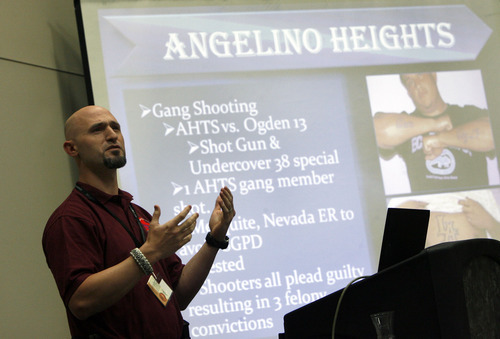This is an archived article that was published on sltrib.com in 2011, and information in the article may be outdated. It is provided only for personal research purposes and may not be reprinted.
A quietly simmering gang problem in St. George reached new heights last summer.
In the early morning hours of July 25, a group of rival gang members argued outside a home in the 2600 East block of 610 North there. As the argument grew increasingly heated, 18-year-old Vincent Garibay pulled out a shotgun and fired at three rivals. His friend, Joe Martinez, 23, grabbed a handgun and fired at the same group. A bullet hit one of their foes.
Instead of bringing the wounded teenager to Dixie Regional Medical Center in St. George, his fellow gang members drove him to a Mesquite, Nev., hospital.
They told Nevada authorities they had been attacked by a Mesquite gang, but detectives from the Washington County Area Gang and Drug Task Force knew better and traced the shooting back to St. George, where the suspects were arrested and later charged.
The shooting victim survived, but the gunfight is evidence that gang crime in Washington County can be violent in a community viewed as a nice place to retire or play golf, said St. George police Detective Johnny Heppler.
"We do have our issues. We have gang influences from Southern California and the Las Vegas area. We're the first pit stop on the I-15 corridor from Southern California on the way to Salt Lake," Heppler said. "St. George has grown. Because of that, our gang issues have grown."
Gang trends in southern Utah were highlighted Thursday at the 21st-annual Utah Gang Conference, sponsored by the Salt Lake Area Gang Project, at South Towne Exposition Center in Sandy. About 850 people from law enforcement, schools, the court system and others who work with juveniles are meeting at the two-day conference to hear about gang suppression, intervention and prevention.
During the gang conference's earliest years, law enforcement officials from southern Utah would attend sessions on gangs active along the Wasatch Front to learn how they operate. But the tables have turned. Agencies from northern Utah are keeping tabs on southern Utah gangs, as those groups seep into new territory. Gangs travel between Salt Lake City and St. George regularly, so it's important to be familiar with all the state's documented gangs, said Aaron Bergquist, a detective with St. George's gang unit.
"It's so important to share information because our gangs are so mobile. Connections are one of the most important things we can form. When these guys flee, when these guys move ... we can call in favors down the road," Bergquist said.
About 450 documented gang members and 200 affiliates — those who hang around gangsters but aren't members — call the St. George area home, Bergquist said.
Gang detectives estimate there are about 35 gangs in southern Utah, the largest a 100-member Sureño gang in St. George called Angelino Heights.
In an unsolved case from 2008, a 12-year-old Angelino Heights member is suspected of stabbing an 11-year-old rival five times at St. George's Dixie Downs Park.
The case has stalled because witnesses refuse to cooperate.
In the past few months, an estimated $20,000 worth of damage from graffiti is believed to have been caused by a Norteño gang made up primarily of white teenagers. The middle schoolers, most from "good families," decided to form their branch after listening to the music of rapper Woodie, Bergquist said.
Police are committed to keeping those episodes from escalating, Heppler and Bergquist said. They cited a 42 percent decrease in graffiti around St. George since 2007, which they attribute to aggressive efforts to catch taggers. In 2008, there were 467 graffiti cases reported, with 223 arrests. Those numbers have remained consistent, Heppler said.
St. George's gang unit is expanding with the city's gang problem. The unit formed 11 years ago with just one detective. This year, it has grown to eight officers.
The gang unit works closely with U.S. Immigration and Customs Enforcement and its Operation Community Shield program, which targets gang members who are in the country illegally, Bergquist said. As a result, about 100 people have been deported from Washington County since 2007. The program has also worked with southern Utah gang detectives to bust large marijuana plots in southern Utah.
Heppler said efforts to target at-risk youths before they join gangs are under way, and the gang unit is pleased when they run into residents surprised to notice officers wearing gang-unit uniforms, Bergquist said.
"We'll go out and do suppression with the gang unit, and people will say, 'We have a gang unit in St. George?' " Bergquist said.
"We always take that as a compliment."





